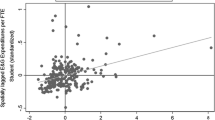Abstract
This study examines an emerging trend in state higher education finance policy: the use of an index to establish tuition and fee levels at public institutions. Based on a national survey of tuition-setting policies, this study documents the increasing use of an indexing formula to determine tuition levels. Factors encouraging this trend are examined, and questions that must be addressed by state and institutional policymakers in adopting such a formula are discussed. Policy implications for states and institutions are also considered.
Similar content being viewed by others
References
Advisory Commission on Intergovernmental Relations.Changing Public Attitudes on Governments and Taxes. Washington, D.C., Author, 1980.
Carnegie Commission on Higher Education.Higher Education: Who pays? Who Benefits? Who Should Pay? New York: McGraw-Hill, 1973.
Centra, John A. College enrollment in the 1980's: Projections and possibilities. Journal of Higher Education, January/February 1980,51 18–39.
Committee for Economic Development.The Management and Financing of Colleges. New York, 1973.
Council for Postsecondary Education, State of Washington.Cost of Instruction Study. A Staff Report in Response to Senate Resolution 1975–131. Olympia, Wash., 1976. (a)
Council for Postsecondary Education, State of Washington.A System of Establishing Tuition and Fees as a Proportion of Educational Costs. Olympia, Wash., 1976. (b)
Frances, Carol.College Enrollment Trends: Testing the Conventional Wisdom Against the Facts. Washington, D.C.: American Council on Education, 1980.
Hyde, William D., Jr.The Effect of Tuition and Financial Aid on Access and Choice in Postsecondary Education. Denver: Education Commission of the States, 1978.
Johnson, Jane L. An analysis of the relationship between instructional costs and differential tuition levels.Journal of Higher Education May/June 1979,50 280–288.
MacDonald, Douglas S.Alternative Tuition Systems. Washington, D.C.: American Association for Higher Education, 1977.
Meisinger, R. J., Jr.State Budgeting for Higher Education: The Uses of Formulas. Berkeley, Calif.: Center for Research and Development in Higher Education, 1976.
Rusk, James J., and Leslie, Larry L. The setting of tuition in public higher education.Journal of Higher Education November/December 1978,49 531–547.
Van Alstyne, Carol. Rationales for setting tuition levels at public institutions.Educational Record Winter 1977,58 66–82.
Western Interstate Commission for Higher Education.High School Graduates: Projections for the Fifty States. Boulder, Colo., 1979.
Western Interstate Commission for Higher Education.Tuition and Fees in Public Higher Education in the West. Boulder, Colo., 1980.
Author information
Authors and Affiliations
Rights and permissions
About this article
Cite this article
Viehland, D.W., Kaufman, N.S. & Krauth, B.M. Indexing tuition to cost of education: The impact on students and institutions. Res High Educ 17, 333–343 (1982). https://doi.org/10.1007/BF00977901
Issue Date:
DOI: https://doi.org/10.1007/BF00977901




